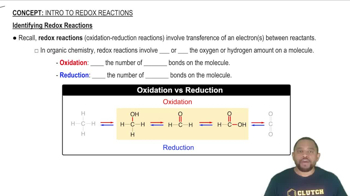Ch.22 - Chemistry of the Nonmetals
Chapter 22, Problem 43
Complete the exercises below. In aqueous solution, hydrogen sulfide reduces dilute HNO₃ to NO₂. In all cases, under appropriate conditions, the product is elemental sulfur. Write a balanced net ionic equation for each reaction.
 Verified step by step guidance
Verified step by step guidance1
Identify the reactants and products in the reaction: Hydrogen sulfide (H₂S) and dilute nitric acid (HNO₃) are the reactants, while nitrogen dioxide (NO₂) and elemental sulfur (S) are the products.
Write the unbalanced chemical equation for the reaction: H₂S + HNO₃ → NO₂ + S.
Determine the oxidation states of the elements involved to identify the changes in oxidation states: Sulfur in H₂S is -2 and becomes 0 in S, while nitrogen in HNO₃ is +5 and becomes +4 in NO₂.
Balance the atoms that change oxidation states: Balance the sulfur and nitrogen atoms by ensuring the number of electrons lost by sulfur equals the number of electrons gained by nitrogen.
Balance the remaining atoms and charges: Add water (H₂O), hydrogen ions (H⁺), and electrons (e⁻) as needed to balance the oxygen and hydrogen atoms, and ensure the charges are balanced in the net ionic equation.
Key Concepts
Here are the essential concepts you must grasp in order to answer the question correctly.
Redox Reactions
Redox (reduction-oxidation) reactions involve the transfer of electrons between species, resulting in changes in oxidation states. In this context, hydrogen sulfide (H₂S) acts as a reducing agent, donating electrons to nitric acid (HNO₃), which is reduced to nitrogen dioxide (NO₂). Understanding the oxidation states of the elements involved is crucial for balancing the reaction.
Recommended video:
Guided course

Identifying Redox Reactions
Net Ionic Equations
A net ionic equation represents the actual chemical species participating in a reaction, excluding spectator ions that do not change during the reaction. To write a net ionic equation, one must first identify the reactants and products, then eliminate the ions that remain unchanged. This simplification helps focus on the essential chemical changes occurring in the solution.
Recommended video:
Guided course

Net Ionic Equations
Balancing Chemical Equations
Balancing chemical equations ensures that the number of atoms for each element is the same on both sides of the equation, adhering to the law of conservation of mass. This process involves adjusting coefficients in front of compounds to achieve balance. In the case of the reaction between H₂S and HNO₃, careful attention must be paid to the stoichiometry to accurately reflect the formation of elemental sulfur and nitrogen dioxide.
Recommended video:
Guided course

Balancing Chemical Equations
Related Practice
